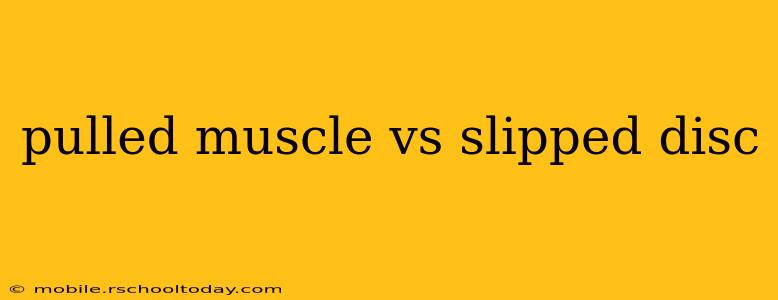Experiencing back pain can be debilitating, leaving you wondering about the underlying cause. Two common culprits are pulled muscles and slipped discs. While both can cause significant discomfort, they are distinct conditions with different causes, symptoms, and treatments. This article will delve into the key differences between a pulled muscle (muscle strain) and a slipped disc (herniated disc), helping you better understand your pain and seek appropriate medical attention.
What is a Pulled Muscle (Muscle Strain)?
A pulled muscle, more accurately termed a muscle strain, occurs when a muscle is overstretched or torn. This often happens during strenuous activity, sudden movements, or repetitive motions. The severity of a strain can range from mild discomfort to a complete muscle tear, requiring significant recovery time.
Symptoms of a Pulled Muscle:
- Localized pain: The pain is typically concentrated in the affected muscle.
- Muscle tenderness: The area feels sore to the touch.
- Muscle spasm: The muscle may involuntarily contract, causing stiffness.
- Limited range of motion: Movement can be restricted due to pain and spasm.
- Swelling and bruising: In more severe cases, swelling and bruising may occur.
What is a Slipped Disc (Herniated Disc)?
A slipped disc, or herniated disc, occurs when the soft, gel-like center of an intervertebral disc pushes through a tear in the tougher outer layer. This can put pressure on nearby nerves, causing pain, numbness, or weakness. This condition commonly affects the lower back (lumbar spine) but can also occur in the neck (cervical spine).
Symptoms of a Slipped Disc:
- Radiating pain: Pain often radiates down the leg (sciatica) or arm, following the path of the affected nerve.
- Numbness and tingling: These sensations are common due to nerve compression.
- Weakness: Muscle weakness in the affected limb may develop.
- Sudden onset of pain: The pain may begin suddenly after a specific event or gradually worsen over time.
Pulled Muscle vs. Slipped Disc: Key Differences Summarized
| Feature | Pulled Muscle (Muscle Strain) | Slipped Disc (Herniated Disc) |
|---|---|---|
| Cause | Overstretching or tearing of a muscle | Protrusion or rupture of the intervertebral disc |
| Pain Location | Localized to the affected muscle | Can radiate down the leg (sciatica) or arm |
| Radiating Pain | Typically absent | Often present |
| Numbness/Tingling | Usually absent | Often present |
| Weakness | May be present, but typically less severe | Can be significant |
| Onset | Can be gradual or sudden | Often sudden, but can also be gradual |
How are Pulled Muscles and Slipped Discs Diagnosed?
Diagnosis typically involves a physical examination by a doctor or physical therapist. Imaging tests, such as X-rays, MRIs, or CT scans, may be necessary to confirm the diagnosis and rule out other conditions. An MRI is particularly useful for visualizing the spinal structures and identifying a herniated disc.
What is the Treatment for a Pulled Muscle?
Treatment for a pulled muscle typically involves:
- Rest: Avoiding activities that aggravate the pain.
- Ice: Applying ice packs to reduce inflammation.
- Heat: Applying heat after the initial inflammation subsides.
- Over-the-counter pain relievers: Medications like ibuprofen or acetaminophen can help manage pain and inflammation.
- Stretching and strengthening exercises: These help restore muscle function and prevent future injuries.
What is the Treatment for a Slipped Disc?
Treatment for a slipped disc depends on the severity of symptoms and may include:
- Conservative management: This includes rest, ice/heat therapy, pain relievers, physical therapy, and epidural steroid injections.
- Surgery: In severe cases where conservative treatment fails to provide relief, surgery may be necessary to decompress the nerve.
Can a Slipped Disc Cause a Pulled Muscle?
While not directly causing a muscle pull, a slipped disc can indirectly contribute to muscle strain. The pain and muscle spasms associated with a slipped disc can lead to compensatory movements and muscle overuse, potentially resulting in a pulled muscle.
How Long Does it Take to Recover from a Pulled Muscle and Slipped Disc?
Recovery time varies significantly depending on the severity of the injury and individual factors. A mild muscle strain may heal within a few weeks, while a severe herniated disc may require months or even longer to fully recover.
This information is intended for educational purposes only and should not be considered medical advice. Always consult a healthcare professional for diagnosis and treatment of any medical condition. They can accurately assess your specific situation and recommend the appropriate course of action.
